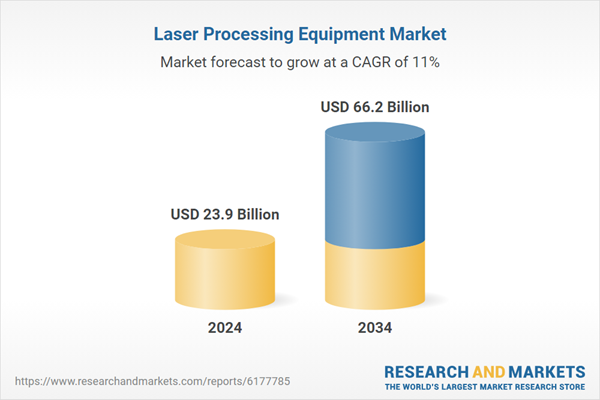The rapid integration of Industry 4.0 innovations, including AI, IoT, and full-scale automation, is reshaping industrial manufacturing and accelerating the adoption of advanced laser processing solutions. Fiber lasers continue gaining momentum due to their energy efficiency, reduced operating costs, and high reliability in demanding environments. Increasing use of laser-based additive manufacturing techniques has further propelled market growth as industries seek faster prototyping and greater design flexibility. Ultrafast and high-power lasers are also becoming essential across critical sectors like aerospace and medical, where accuracy and customization are vital. Rising expectations for precision, along with growing demand for sustainable manufacturing practices, are fostering continuous R&D. The industry’s expansion is supported by scalable applications, such as micromachining, engraving, drilling, and structural cutting, all benefiting from precise, non-contact processing. These evolving use cases, coupled with favorable cost-to-performance ratios and an expanding industrial base, will continue to shape global market dynamics in the years to come.
The fiber lasers category segment generated USD 12.3 billion in 2024, driven by their superior energy conversion efficiency and low maintenance requirements. Their consistent beam quality allows for detailed processing, which has become essential for high-tolerance operations across several advanced manufacturing environments. Reduced energy consumption translates into lower operational costs, making fiber lasers a preferred choice among cost-conscious industries. Their minimal material waste output and precision-focused performance align well with stricter production and sustainability standards being introduced across global manufacturing landscapes. Continuous improvements in fiber laser reliability and lifespan further enhance their adoption rate.
The cutting and drilling segment held a 51.2% share in 2024, driven by the need for intricate shaping and precise material removal. Laser processing is recognized for minimizing material wastage, supporting lean manufacturing models, and improving cost-efficiency. Its adaptability in handling metals, plastics, ceramics, and composite materials makes it a key tool across multiple verticals. From automotive assembly lines to medical device fabrication, the ability to perform complex operations with accuracy has cemented laser cutting and drilling as standard processes in modern industrial workflows.
U.S. Laser Processing Equipment Market held 65% and generated USD 3.5 billion in 2024. The country's innovation-focused ecosystem, combined with its advanced manufacturing infrastructure, continues to support product development and widespread adoption. The diversity of industries such as aerospace, electronics, automotive, and healthcare is driving consistent investment in next-generation laser technologies. Strong domestic R&D initiatives and the presence of global manufacturing leaders further reinforce the country’s dominant position within the region.
Prominent companies shaping the Global Laser Processing Equipment Market include IPG Photonics, TRUMPF, Hans Group, Control Micro Systems, Vermont, Newport, Coherent, Rofin-Sinar Technologies, Lumibird, Universal Laser Systems, Eurolaser, Laser Systems, Concept Laser, Jenoptik, and Hgtech. Companies in the laser processing equipment market are strengthening their global footprint by focusing on innovation, efficiency, and sector-specific solutions. Many are investing heavily in R&D to develop compact, high-power laser systems tailored for precision industries. Customization and modular equipment designs are helping manufacturers cater to niche applications across the medical, aerospace, and electronics sectors. Strategic collaborations with OEMs and industrial automation providers are expanding the reach of their technologies. Firms are also scaling up production capabilities while emphasizing eco-friendly operations to meet the rising demand for sustainable manufacturing.
Comprehensive Market Analysis and Forecast
- Industry trends, key growth drivers, challenges, future opportunities, and regulatory landscape
- Competitive landscape with Porter’s Five Forces and PESTEL analysis
- Market size, segmentation, and regional forecasts
- In-depth company profiles, business strategies, financial insights, and SWOT analysis
This product will be delivered within 2-4 business days.
Table of Contents
Companies Mentioned
The companies profiled in this Laser Processing Equipment market report include:- Coherent
- Concept Laser
- Control Micro Systems
- Eurolaser
- Hans Group
- Hgtech
- IPG Photonics
- Jenoptik
- Laser Systems
- Lumibird
- Newport
- Rofin-Sinar Technologies
- TRUMPF
- Universal Laser Systems
- Vermont
Table Information
| Report Attribute | Details |
|---|---|
| No. of Pages | 155 |
| Published | September 2025 |
| Forecast Period | 2024 - 2034 |
| Estimated Market Value ( USD | $ 23.9 Billion |
| Forecasted Market Value ( USD | $ 66.2 Billion |
| Compound Annual Growth Rate | 11.0% |
| Regions Covered | Global |
| No. of Companies Mentioned | 16 |









